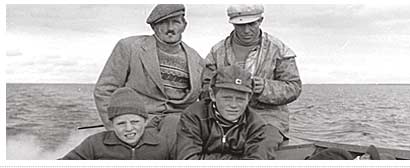

![]()
 |
|||||
 |
|||||
|
|||||
|
|
|
|
|
|
|
|
The way of life of the Inari Sámi can be depicted by the long development of means of livelihood and the ability to survive in the natural circumstances present. The climate has set certain limits on life and occupations. A cold climate and short growing season compared to that of regions further south limits agriculture. On the one hand, the light season made activity imperative and on the other hand the heart of winter made it possible to take it easier. However, even during Kaamos and in the dark it was possible to be busy with sundry other activities. A reindeer herder knew how to skin a reindeer even in the dark. Almost nobody experienced the dark kaamos season as unpleasant, as did people coming from the south. The traditional form of life for the Inari Sámi consisted in its most typical aspects in a home life where reindeer husbandry, small scale cattle farming and agriculture, hunting, fishing and berry picking were practiced. These occupations were tightly interwoven with the changes of seasons. Typical of the Inari Sámis was the varriistâllâm, or move in spring to the summer home and in the autumn to the wintering home. The way of life of the Inari Sámi was thus an interaction with nature. All activity had its time. Work had to be done when it was timely to do it and when the weather made it possible. For example, reindeer moss (lichen) could be harvested only during a slight drizzle or in foggy weather. It was not possible if it was too dry or too wet. Even the timing of cutting shoe hay was significant. One needed to also be ready to work at night. For example, during a dry season sedge grass that was fragile due to being dry could be gathered only during the night dew. There were always things to do at other times such as making firewood, handicrafts; reindeer herding meant calving, the insects, fur changes, mating season, etc.: all these were things that led to work done in their own time. Values The Inari Sámis had values and customs that were never written, but were taken into consideration in living and dealing with other people. In the use of nature, such as with reindeer moss, fishing or cloudberry picking, there were unmarked boundaries between houses which were not necessarily even agreed on, but not lightly transgressed. People who received respect in the Inari Sámi society were those who fared well in nature, who knew how to travel without getting lost. This fact is expressed in the verb täiđid, and the person who possessed this talent is taiđiš. Hunting and reindeer herding skills were considered important; it was good to be able to shoot well and throw a lasso skillfully. A broad knowledge and memory of reindeer earmarks was valued. Skill in handicrafts and handiness in general was an advantage, for example, in choosing a spouse. Women, as well as having to be diligent, had to be clean, ruddy complexioned and round. It was an advantage for candidates as husbands if he did not drink to excess or play cards. An eligible spouse had to belong also to a good family. All people were to be treated politely and with consideration. It was not allowed to speak to anyone disrespectfully, mockingly or offensively. There were two forms of behavior towards Finns. On the one hand, value was given to civilized behavior and affluence, but on the other hand, lack of ability in Sámi skills was not respected. Being Sámi was generally valued, and to be a reindeer herder was to be a good Sámi. The above written describes the situation before
the arrival of the motor and computers, before long periods of study.
The Sámi ways of life and values have not disappeared, at least
not in everyone. They are still discernible in contemporary life.
|
| ||||||||||||
| © 2006 Sámi musea Siida & Anarâškielâ servi siida@samimuseum.fi |